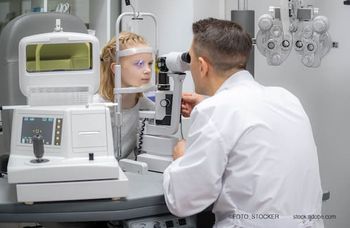
A closer look at riboflavin application for corneal collagen crosslinking
Corneal collagen crosslinking with riboflavin works well but requires further exploration to identify the best approach for various types of patients.
Take-home message: Corneal collagen crosslinking with riboflavin works well but requires further exploration to identify the best approach for various types of patients.
By Vanessa Caceres
New riboflavin formulations for corneal collagen crosslinking (CXL) could make the procedure more effective for keratoconus and ectasia, said George O. Waring IV, MD, FACS, director of refractive surgery, Storm Eye Institute, Medical University of South Carolina, Charleston, and adjunct assistant professor of bioengineering, Clemson University, Clemson, S.C.
Dr. Waring pointed to published studies that have found positive results from different CXL approaches involving riboflavin. One such study that Dr. Waring participated in along with Japanese researchers focused on the effectiveness of accelerated CXL with riboflavin for keratoconus.1 Researchers evaluated the change in dioptric power and corneal topography.
The study involved accelerated CXL treatments using a 10-minute riboflavin soak and three minutes of ultraviolet-A radiance at 30 mW/cm,2 which corresponded to 5.4 J/cm.2 In the 22 patients (39 eyes), the mean uncorrected distance visual acuity had a statistically significant improvement from 1.11 logMAR preoperatively to 0.89 logMAR at six months postoperatively. Mean maximum keratometry readings also improved. Researchers concluded that accelerated CXL had similar results to conventional CXL and that the procedure has the potential to treat and stop the progression of keratoconus.
Dr. Waring also addressed results related to transepithelial CXL â also known as epi-on, which involves leaving the epithelium intact during treatment.
“We’re getting more and more signals that this approach seems to work, but the question is, does it work as well as epi-off?” he said. “Sufficient exposure time for increased riboflavin delivery and oxygen exposure during treatment is required to get a meaningful effect.”
An emerging treatment using riboflavin is iontopheresis, a CXL approach developed by SOOFT Italia and CE-marked in Europe. Iontophoresis has been in development for a number of years for other applications, in addition to riboflavin delivery, and has compelling results, Dr. Waring said. The use of this approach was based on preclinical data with rabbits and evaluated riboflavin concentration in the stroma in rabbits treated with transepithelial CXL compared with those that had only saline treatment.
Yet another approach Dr. Waring shared was LASIK Plus/LASIK Extra, which involves combining LASIK with a brief application of riboflavin and UV light. “The potential benefit here is clear. Borderline candidates for LASIK may benefit and in a study we conducted with Minoru Tomita in a large series at the Shinagawa clinic in Japan, the combined treatment was safe and we observed refractive stability, and this may be a benefit in populations where regression rates may be higher,”2 Dr. Waring stated.
Ultimately, researchers and clinicians still have some work to do to determine the best method for CXL and riboflavin application, Dr. Waring concluded.
Corneal collagen crosslinking is not approved in the U.S. by the Food and Drug Administration, although there are a number of ongoing trials for it.
References
- Mita M, Waring GO 4th, Tomita M. High-irradiance accelerated crosslinking for the treatment of keratoconus: Six-month results. J Cataract Refract Surg. 2014;40:1032-1040.
- Tomita M, Yoshida Y, Yamamoto Y, Mita M, Waring G 4th. In vivo confocal laser microscopy of morphologic changes after simultaneous LASIK and accelerated collagen crosslinking for myopia: one-year results. J Cataract Refract Surg. 2014;40:981-990.
George O. Waring IV, MD, FACS
This article was adapted from Dr. Waring’s presentation at the American Society of Cataract and Refractive Surgery annual meeting in San Diego earlier this year. His presentation was part of a symposium on CXL and was entitled “New Technologies on Riboflavin Formulation”
Newsletter
Don’t miss out—get Ophthalmology Times updates on the latest clinical advancements and expert interviews, straight to your inbox.



















































.png)


